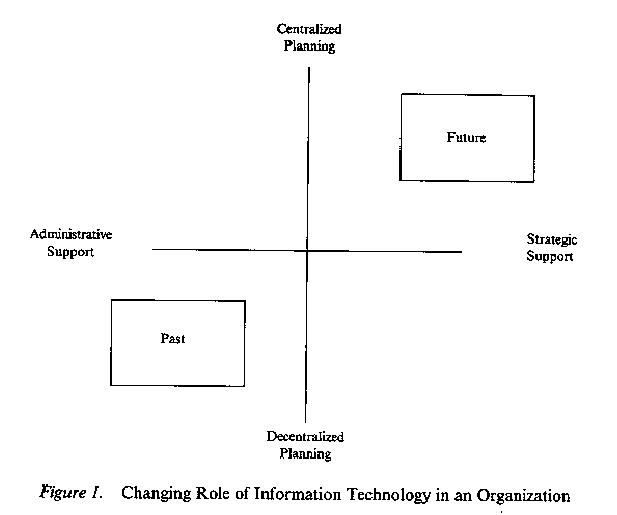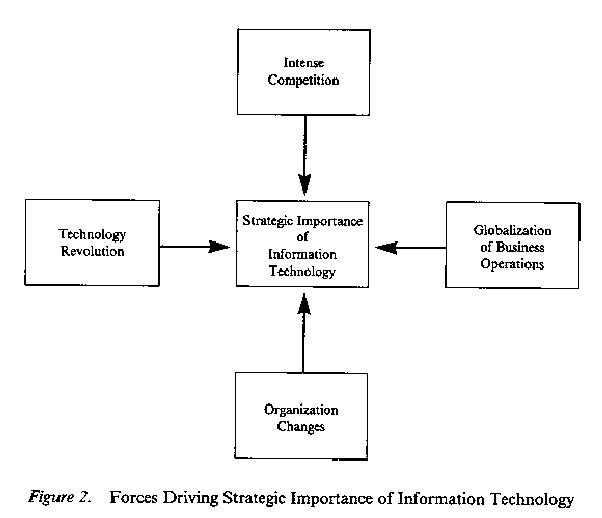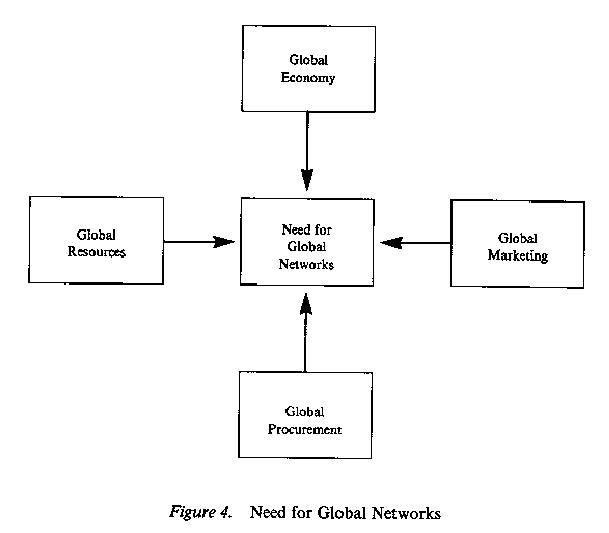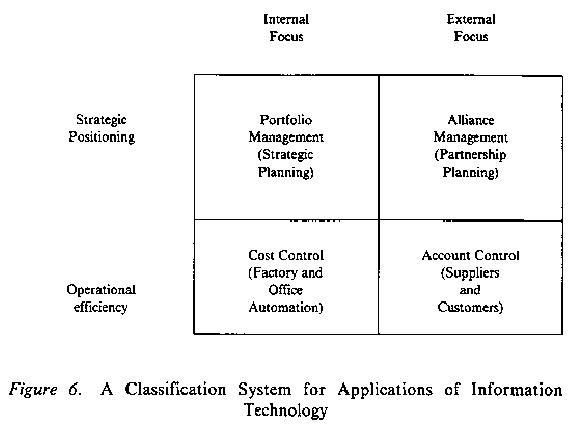The purpose of this paper is to examine the changing role of information technologies (computers, networks, and terminals) especially in large organizations. The paper is divided into three Sections. The first part examines the changing role of information technology. The second part discusses four major forces which are responsible for this changing rote. And the last section provides a framework of applications of information technologies in large organizations.
Changing Role of Information Technology
Today, information is increasingly recognized as a key source of the organization comparable in importance to capital and human resources. Some experts believe that just as labor was probably the most critical resource in the agricultural age, and capital was the most critical resource in the industrial age, information will be the most critical resource in the post-industrial age. Many believe that the way organizations manage information will increasingly determine their survival and growth in the future (Peter Drucker, “The Coming of the New Organization,” Harvard Business Review, Volume 88, January- February 1988, pp. 45-53).
I have identified two key dimensions on which the role of information technology i changing in an organization.
First, information technology is clearly shifting away from the support and administrative function to the more mainstream and strategic function. Unlike other support functions, such as training, travel, and personnel, information technology is considered extremely important for the revenue generating operations or divisions of the organization. This is especially true in those organizations where just in time operations are highly critical, for example, in banking, retailing, and emergency services.
In a recent survey of companies which put high technology to work, the top 10 companies in diverse industries had one thing in common: they had elevated the role of information technology from the administrative support function to a more strategic operations integrated function (High Technology Business, June 1988, pp. 22-34).
For example, both Citicorp and American Express outdistance their competitors in the use of information technologies. Citicorp spends an estimated $900 million annually on computer hardware, software and research and development—about twice as much as its nearest rival, Bank of America. The worldwide network of American Express for credit card verification, as well as the database management expertise including artificial intelligence, are an industry showcase.
In the oil and chemicals business, DuPont is pouring millions of dollars into expert systems that mimic the problem-solving abilities of sages who have devoted their careers to learning the intricacies of industrial chemical processing. Another example of DuPont’s commitment to using information technology is its investment in advanced computing. They were the first in the chemicals industry to get a Cray supercomputer, which helps DuPont researchers develop new classes of products, particularly in pharmaceuticals. Its automated software development system, which uses computers to write other computer programs, is working so well that DuPont has formed a separate organization to sell it to the outside world.
At Wal-Mart Stores, computerized inventory control systems electronically order merchandise from suppliers and maintain order in warehouse and distribution from a store’s receiving dock to its shelves. The retailer’s latest technology feat is the Wal-Mart Satellite Network (WSN)—a multimillion dollar project to join more than 1,200 Wal-Mart facilities in a private, two- way satellite communications network. In WSN’s inaugural broadcast. chairman and founder Sam Walton appeared on television at Wal-Mart Stores, leading the company’s more than 185,000 employees in a simultaneous Wal-Mart cheer.
Other examples include Martin Marietta and TRW in the defense industry; Apple and Hewlett-Packard in computers and electronics; Archer Daniel Midland (ADM) and Kellogg in food processing; 3M and General Electric in general manufacturing; Merck and Abbott in pharmaceuticals; Nucor and Carpenter Technology in steel and metals; and Federal Express and American Airlines in the transportation industry.
The second dimension of the changing role of information technology is that it is gaining top management attention. In some organizations, top management is directly involved in leading the way in the organization for making use of information technologies. For example, at General Motors, it is reported that Roger Smith’s personal interest in greater use of computers and communications as a strategic resource led to the acquisition of EDS and Hughes.
Alternatively, the information technology function is increasingly reporting to the CEO as, for example, at Sears. They have formed a separate subsidiary called Sears Communications Network (SCN) that reports directly to the chairman, Edward Brennan. Similarly, at APL., a container shipping company based in Oakland, California, information technologies are centralized and report directly to the CEO.
Finally, in some instances, information technology organization is asked to both review and participate in the long-term strategic plans of operating divisions or subsidiaries. This is true at Sears, Merrill Lynch, and Security Pacific Bank.
Gaining top management attention has often resulted in integrating data processing and telecommunications functions under one organization, in centralizing the information technology organization and in creating a position of either vice president of information services or chief information officer (CIO). In short, information technology has shifted from a highly decentralized support operation to a centralized strategic function.
The changing role of information technology in an organization can be summarized as in Figure 1. It is shifting from the administrative support function to a strategic integrated operation, and from a decentralized to a centralized coordination and management.
Why is Information Technology Becoming a Strategic Resource?
A number of forces are responsible for the changing role of information technology in an organization. I have identified four distinct forces which seem to be driving the strategic importance of information technology. They are:
(a). Intense Competition. Intense competition is forcing the organizations to become more efficient and effective. One way to increase efficiency and effectiveness is the use of information technology.
(b). Globalization of Business Operations. As the industry becomes more global in its procurement, manufacturing and marketing operations, it requires greater use of information technology to reduce time and space barriers.
(c). Organizational Changes. With constant reorganization, as well as increased mergers and acquisitions, top management recognizes the need for flexibility through compatible information technologies.
(d). Technology Revolution. The performance-price ratio of a new generation of information technologies is making them more affordable and useful to the organization.
Figure 2 depicts the four drivers of the changing role of information technology, in this section of the report, we will discuss why and how each force is enhancing the strategic importance of information technology.
Intense Competition
In most advanced countries, industries are at the maturity stage of the life cycle. As the industry matures, lack of growth and excess capacity often result in market share battles between two or more very large competitors. For example, we are witnessing market share battles in the steel, metal, chemical, processed foods, mainframe computing, automobile and appliance industries.
One way to gain competitive advantage over others is the use of information technologies. I have identified at least four ways a company can gain competitive advantage with the use of information technologies.
First, it reduces the operating costs through office or factory automation. For example, telephone companies have computerized billing, account management, and operator services with the use of information technologies that result in significant cost savings. Similarly, travel agents have reduced the cost of operating the business through computerized travel reservations. Hotels and motels have significantly reduced their operating costs by computerizing guest reservations, billing and physical facilities.
Second, it improves product or service quality by providing quality assurance. There is less error per unit of activity. Perhaps the best example of this is the scanner technology. The Universal Product Code (UPC) bar chart labels provide superior quality assurance at the supermarket check-out counters, airline baggage handling, as well as merchandise management in retail stores.
Third, information technology can provide value-added services which create differentiation. For example, Federal Express has extensively used information technologies not only to enhance its reliability of overnight delivery of packages, but also to continuously inform customers where their packages are in transit. This value-added service, also utilized by APL in the container cargo business, provides a competitive advantage through differentiation.
Finally, information technology can be used for competitive intelligence. The Sabre system developed by American Airlines provides the airline enormous competitive intelligence. Every airline has to deposit its schedule and fares, which allows American Airlines to adjust its schedules and fares to compete more effectively.
Thus, there are at least four ways an organization can gain competitive advantage by using information technologies. (See Figure 3.)
Globalization of Business Operations
Globalization of business operations is a second major force which is responsible for the increasing strategic importance of information technologies.
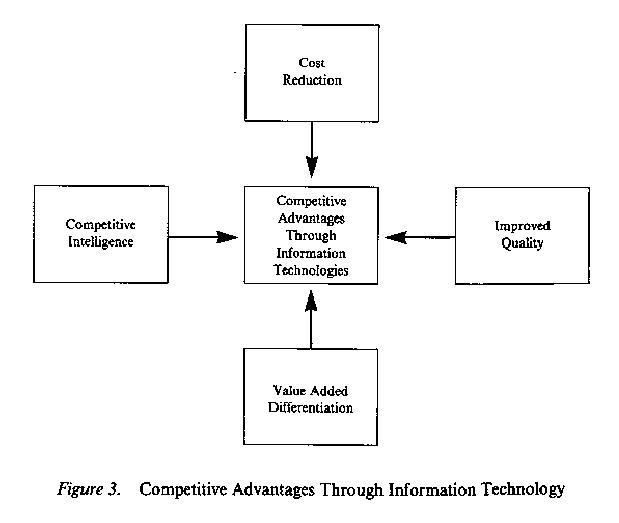
In virtually all businesses, whether they are high tech or low tech, consumer or industrial, products or services, there is at least some degree of global business operations. This can be as simple as global procurement of materials, components or products or as complex as fully integrated global operations.
Global business operations require that both time and distance barriers be eliminated or reduced between the organization, its suppliers, its customers, its shareholders and its people. What becomes necessary is on-line or just in time communication, coordination and control of physical, financial and human resources. It is no wonder that information products and services including FAX, data networks, personal computer terminals, and private lines have been growing rapidly around the world. It is especially true today as the triad markets (North America, Europe and Japan) have become highly interdependent through global competition, global mergers and acquisitions and global business operations. The multinationals from these countries are truly global in their business scope.
Perhaps the best example of truly global business operations is investment banking. They not only trade, borrow and invest capital across global financial markets, but many large full-service banks from the United States, Japan, and Europe virtually move their financial factories (portfolios) around the world on a daily basis. This requires a highly centralized, integrated, and dedicated on-line information system which is secure, accurate and reliable. Indeed, some experts believe that the major stock exchanges of the world are now fully interdependent on one another and are capable of offering 24 hour trading. Some even believe that the high degree of stock market volatility and the recent stock market crash of 1987 are largely due to on-line computerized information technologies. This allows investors to make decisions on a minute-by-minute basis instead of the daily trading cycles common prior to the use of information technologies.
Next to the financial and airline services, I believe retailing is heavily influenced by global business operations. Most of the retail merchandise, especially in the United States, cornea from offshore markets and requires computerized inventory control, order entry systems, and just in time operations across national boundaries. This seems to be extremely critical in many highly perishable products such as fresh produce and fashion garments. Therefore, both Benetton and The limited have integrated information systems that act as the backbone of their daily operations.
Finally, rationalization of manufacturing capacity on a global basis through international mergers and acquisitions has further necessitated the development and deployment of global networks to coordinate manufacturing of parts, assembly, and fabrication across national boundaries. This is, for example, true in electronics, automobiles and more recently in appliances industries.
In summary, four areas of global business operations—global procurement, global marketing, global resources and global economy—are creating a need for information technologies to minimize or eliminate time and distance barriers (see Figure 4.)
Organizational Changes
A third major force, and probably a more immediate reason for the increasing the importance of information technologies, is organizational change, especially the reorganization of corporations. I have identified several aspects of organization changes that have become the driven for changing the role of information technologies.
The first, and probably most important, reorganization reason is cost efficiency through consolidation and automation of functions. For example, in many industries, middle management ranks have been eliminated by flattening the organization, as well as consolidating the support functions such as clerical, secretarial and staff organizations. This is also true for the organization in charge of information technologies: both data processing and telecommunications functions are increasingly integrated and consolidated. In many organizations, top management has recognized that it is better to invest in capital spending in order to reduce operating costs.
Second, we have witnessed a significant number of domestic mergers and acquisitions in many industries especially in the last decade. The energy crisis of the 1970s led to mergers and acquisitions in the oil industry deregulation of the airlines industry resulted in industry consolidation; and more recently, as a consequence of global competition, there have been large scale mergers and acquisitions in the automobile, appliances and financial services industries. These mergers and acquisitions require reorganization and rationalization of respective information technologies. For example, in the airlines industry, you need to integrate flight schedules, aircrafts, crew, ground personnel, marketing and computer systems of airlines that merge with one another. It is a massive change, and the consolidated data processing and telecommunications departments become a significant resource for top management attention.
Third, crisis management and security of physical and human resources has become a major issue in recent years. Major industrial crises, including the Three-Mile Island nuclear plant accident, Bhopal tragedy in India, and Tylenol product tampering in the United States, have all resulted in top management’s personal involvement in crisis management. ft is recognized that with adequate information technologies, it is possible to prevent, abate, contain or at least quickly respond to corporate crises such as earthquakes, major fire, random shootings, or stealing proprietary information.
Finally, as major industries mature and competition intensifies, they are reorganizing to become market driven. When an organization shifts from product divisions to market divisions, the value chain and flow of operations change significantly. For example, manufacturing is driven less by parts and materials and more by customer demand. Demand driven manufacturing requires significant reorganization of functional activities and support systems. This directly impacts information technologies. Indeed, many of the functions arid activities cannot be carried out efficiently without customer order entry systems, database management and, in genera], on-line integrated information systems.
Four organization issues (mergers and acquisitions, downsizing and consolidation, market driven reorganization and crisis management) are responsible for the increasing importance of information technologies. This is summarized below in Figure 5.
Information Technology Revolution
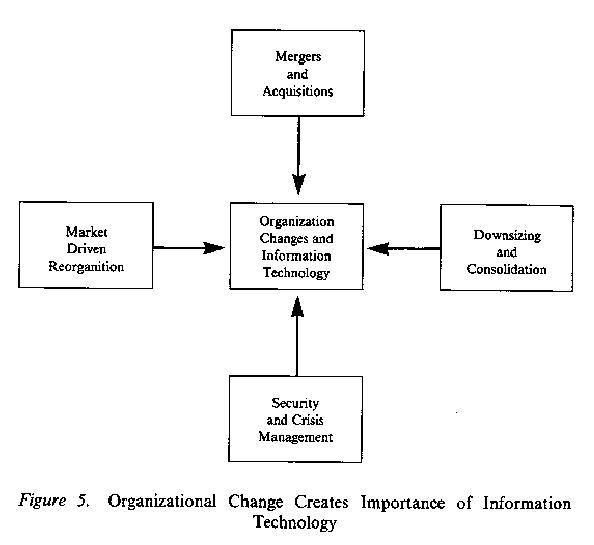
While the first three forces create the need, information technology revolution is the enabling force for increasing the strategic importance of information technologies. It is truly a technology revolution because in a very short period of time (less than 25 years) we have seen commercialization of very innovative information technologies. I believe there are three fundamental dimensions of information technology revolution.
First, we have achieved extremely sharp experiences in information technologies resulting in increased value in use. For example, personal computers today offer memory and processing capabilities at a fraction of the cost of mainframe computing only a decade ago. Similarly, who would have imagined that the facsimile machines will be as affordable as featured calculators and telephone terminals? No wonder today FAX is growing very rapidly and is no longer a product or service strictly for big business. Small business and residence customers are now able to afford many information technologies because of low cost, high performance products and services. And this is not limited to terminals. We are witnessing similar cost reductions in fiber optics, switching systems, and digital services.
Second, information technologies have become distributed over time with respect to processing, memory, switching and intelligence. In other words, it is no longer necessary to have these capabilities exclusively in a centralized location, such as in the mainframe CPU or in the central office switch. It is possible to distribute these capabilities at the end user level. This reduces bottlenecks, dependence on experts, and large capital expenditures to properly use information technologies. At the same time, if multiple users are capable of processing, storing, and switching information, it is logical to expect a sharp increase in networks for connectivity purposes. We have accordingly seen an explosion in local area networks, metro area networks and global networks to fully exploit the capabilities of affordable information technologies.
Finally, information technologies are increasingly integrated. With the advent of end to end digital technologies, (terminals, processors, transport, etc.), it is possible to transmit, store, process and distribute different forms of information (voice, data, video, text) on a single integrated technology. In the old days, it required specialized technologies for voice, data and video communication, for example. Integration of all types of information on a common network with worldwide standards is the hopeful evolution of digital networks and terminals, and it seems to be nearing reality sooner than what we expected.
The three characteristics of information technologies (sharp experience curves, distributed processes, and integration of information) are bridging the gap between needs and usage resulting in their increasing importance in organizations.
How are the Organizations Likely to Use Information Technologies?
Information technologies are used by organizations in a variety of innovative ways. They have become the tools to meet corporate objectives of efficiency and effectiveness. A number of books have been written in recent years that discuss specific case histories. We will try to categorize the use of information technologies by developing a conceptual framework. This framework is represented in Figure 6.
Typically, an organization, due to any one of the reasons discussed above, initially uses information technologies for cost control purposes. The focus is at’ internal efficiency in operations, and the primary targets are the major operations cost centers such as the factory or the office. This provides excellent opportunities for factory or office automation. In general, the emphasis is on single location displacement technologies such as computers, word processors and computerized process technologies. In this setting, it is usually the data processing industry which tends to provide expertise and products as compared to the telecommunications industry. In short, boxes are more important than networks when an organization uses information technologies for internal cost control purpose.
The application focus then shifts toward external inter-organizational operations. It usually begins with linking the suppliers to the newly created factory automation, as well as the use of just in time, statistical process quality control, and computerized design, engineering and manufacturing, linking suppliers for ongoing relationship often results in account control. This has been true in many large Japanese manufacturing companies, including Mitsubishi, Toyota, and Matsushita, where the suppliers virtually depend on the Japanese Corporations for their survival and growth.
In some instances, another external linkage critical to the organization is the customer. Enabling customers to have computerized order entry systems not only makes sales and service more efficient and convenient, but also creates exit barriers for the customer to switch to a competing vendor. This was one of the reasons for American Hospital Supply to offer computerized order entry system to hospitals, clinics, and physicians for medical supplies.
Federal Express went one step further. It built mini warehouses at its Memphis hub for several key accounts and began to manage the pails inventories for such companies as General Electric, Caterpillar and Boeing. By showing that Federal Express was eliminating the cost of picking up and transporting packages to their Memphis hub for the overnight delivery, it offered this value-added service at no extra cost. AU that the parts managers had to do was to use a terminal to send requests to Federal Express for shipment of Paris to different customers. Although this is very convenient and efficient for the customer, it also creates exit barriers. It is very difficult for the customer to shop around for prices or switch vendors. It results in account control. In short, account control (supplier or customer) creates a competitive advantage through value-added service. However, unlike cost control through factory or office automation, it becomes immediately necessary to focus on connectivity across distance and time barriers, and therefore the focus shifts from products (terminals, computers) to networks.
A third way to use information technologies is for internal planning purposes. As large corporations begin to manage a multi-division multi- product organization, due to mergers, acquisition and alliances, it becomes increasingly necessary to both standardize and centralize the strategic planning process. Both of those conditions encourage greater use of information technologies. Indeed, in many organizations, it is possible to eliminate the strategic planning department and still retain the process by developing decision support systems. Database management capabilities are extremely critical in this case. While the focus is on the centralized, single location displacement of professional staff, it is important to note that it is not hardware architecture but software capabilities that are key to this application of information technologies. In other words, application-based, customized software systems become extremely critical—unlike the hardware configurations of a typical mainframe computer company or an office equipment vendor.
This use of information technologies for internal planning purposes is relatively new. Most hardware manufacturers have discovered that they have a weakness. They are not equally good at customized software or database management skills nor are they capable of offering a vendor independent environment.
It is, therefore, not surprising that more generic operating systems, such as UNIX and higher level user languages such as the C language, have become extremely popular in recent years. It is also not surprising to see many consulting companies, such as Arthur Andersen, Boston Consulting Group, A.D. Little and others are invited to develop computerized planning tools and processes.
The last category of application of information technologies is more recent and emergent. ft is the linking of independent organizations for partnership purposes. I refer to this as Alliance Management. These alliances can be a research consortium, co-development, shared manufacturing, marketing or support services. For example, in the defense industry, alliances even among competitors are very common. Some companies become the prime contractor and others participate as subcontractors in one project and reverse the roles in another defense project. Alliance management becomes a critical competitive advantage and companies are increasingly utilizing information technologies for organizing and managing alliances.
Alliance management across multiple organizations requires network solutions. Furthermore, the capabilities in the network needed are not limited to connectivity but also extend to network intelligence and control. This requires distributed processing, memory, switching and signaling capabilities to enable professionals across independent organizations to work together, communicate and coordinate their activities.
Conclusion
Information technologies (computers, networks and terminals) are increasingly regarded as strategic resources of an organization. In the process, they are gaining top management attention. More and more managers in charge of computers and communications are involved in the strategic planning process of the organization; in some industries, notably financial services, passenger airlines and retailing, they are elevated to the position of Chief Information Officer (CIO).
Four forces are responsible for the increasing importance of information technologies. First, intense competition has encouraged organizations to become cost efficient and to differentiate themselves by value-added services. Both of these objectives are increasingly achieved by deploying information technologies. Second, global business operations have necessitated use of online computerized networks to minimize time and distance barriers. Third, organization changes created by mergers and acquisitions, by downsizing the organization or by market-driven reorganizations have necessitated consolidation and centralization of information technologies. Finally, information technologies have become more affordable and improved their performance in recent years. Sharp experience curves, distributed processing and communication, and integration of alternative technologies all have made information technologies more capable of solving organizational structure and Strategy issues.
Information technologies have evolved over time in their applications. Although they started out primarily as cost control applications by focusing internally on factory and office automation, they are increasingly utilized for account control by externally linking suppliers and customers. Recently, they are also used for corporate strategic planning. Arid finally, they are likely to be used more and more for managing alliances among multiple organizations.
Information technologies began as single location centralized hardware products used primarily for cost control purposes. However, they are likely to migrate more toward multi-location distributed network oriented services as organizations utilize them for managing more complex relationships across different organizations.



